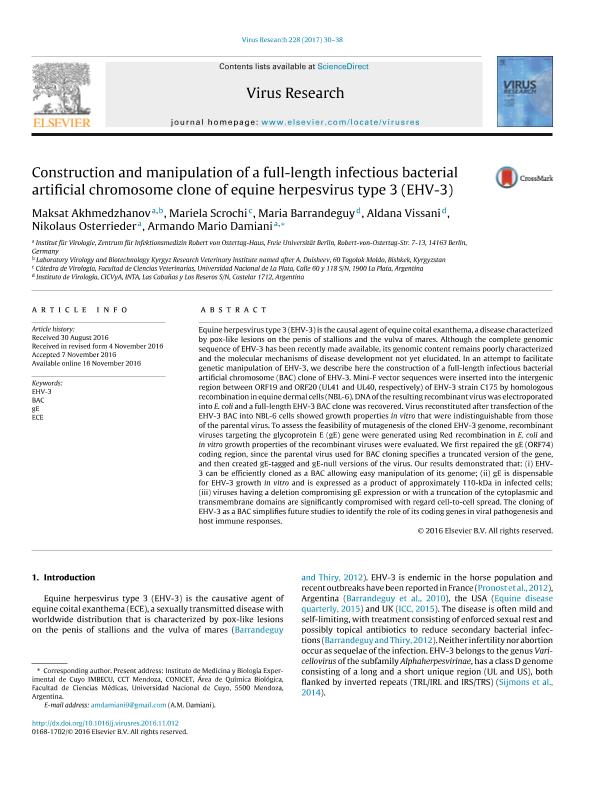Artículo
Construction and manipulation of a full-length infectious bacterial artificial chromosome clone of equine herpesvirus type 3 (EHV-3)
Akhmedzhanov, Maksat; Scrochi, Mariela Rita ; Barrandeguy, María Edith; Vissani, Aldana; Osterrieder, Nikolaus; Damiani, Armando Mario
; Barrandeguy, María Edith; Vissani, Aldana; Osterrieder, Nikolaus; Damiani, Armando Mario
 ; Barrandeguy, María Edith; Vissani, Aldana; Osterrieder, Nikolaus; Damiani, Armando Mario
; Barrandeguy, María Edith; Vissani, Aldana; Osterrieder, Nikolaus; Damiani, Armando Mario
Fecha de publicación:
01/2017
Editorial:
Elsevier Science
Revista:
Virus Research
ISSN:
0168-1702
Idioma:
Inglés
Tipo de recurso:
Artículo publicado
Clasificación temática:
Resumen
Equine herpesvirus type 3 (EHV-3) is the causal agent of equine coital exanthema, a disease characterized by pox-like lesions on the penis of stallions and the vulva of mares. Although the complete genomic sequence of EHV-3 has been recently made available, its genomic content remains poorly characterized and the molecular mechanisms of disease development not yet elucidated. In an attempt to facilitate genetic manipulation of EHV-3, we describe here the construction of a full-length infectious bacterial artificial chromosome (BAC) clone of EHV-3. Mini-F vector sequences were inserted into the intergenic region between ORF19 and ORF20 (UL41 and UL40, respectively) of EHV-3 strain C175 by homologous recombination in equine dermal cells (NBL-6). DNA of the resulting recombinant virus was electroporated into E. coli and a full-length EHV-3 BAC clone was recovered. Virus reconstituted after transfection of the EHV-3 BAC into NBL-6 cells showed growth properties in vitro that were indistinguishable from those of the parental virus. To assess the feasibility of mutagenesis of the cloned EHV-3 genome, recombinant viruses targeting the glycoprotein E (gE) gene were generated using Red recombination in E. coli and in vitro growth properties of the recombinant viruses were evaluated. We first repaired the gE (ORF74) coding region, since the parental virus used for BAC cloning specifies a truncated version of the gene, and then created gE-tagged and gE-null versions of the virus. Our results demonstrated that: (i) EHV-3 can be efficiently cloned as a BAC allowing easy manipulation of its genome; (ii) gE is dispensable for EHV-3 growth in vitro and is expressed as a product of approximately 110-kDa in infected cells; (iii) viruses having a deletion compromising gE expression or with a truncation of the cytoplasmic and transmembrane domains are significantly compromised with regard cell-to-cell spread. The cloning of EHV-3 as a BAC simplifies future studies to identify the role of its coding genes in viral pathogenesis and host immune responses.
Palabras clave:
Bac
,
Ece
,
Equid Herpesvirus 3
,
Ge
,
Ehv-3
Archivos asociados
Licencia
Identificadores
Colecciones
Articulos(IMBECU)
Articulos de INST. DE MEDICINA Y BIO. EXP. DE CUYO
Articulos de INST. DE MEDICINA Y BIO. EXP. DE CUYO
Citación
Akhmedzhanov, Maksat; Scrochi, Mariela Rita; Barrandeguy, María Edith; Vissani, Aldana; Osterrieder, Nikolaus; et al.; Construction and manipulation of a full-length infectious bacterial artificial chromosome clone of equine herpesvirus type 3 (EHV-3); Elsevier Science; Virus Research; 228; 1-2017; 30-38
Compartir
Altmétricas



